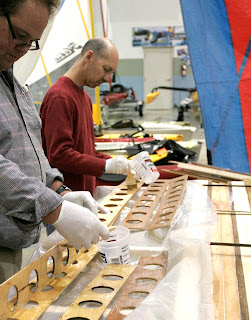We are offering a boat building class in conjunction with St. Louis Sail and Paddle this November.
We have a couple people signed up for the SUP class and we have room for a couple more.
If you are interested please call David @ (314) 308-3753
or Chris at St Louis Sail & Paddle
The final cut off will be Halloween!
http://www.stlouissailandpaddle.com/
The Sea State Stand Up Paddle
Board Building Class
Build a SUP @
St. Louis Sail and Paddle!
WHEN: 4 Tuesday evenings: November 6, 13, 20, 27; 6:30-8pm
WHERE: St. Louis Sail and Paddle, storage of projects is provided during November.
HOW MUCH: The fee for the SUP class is $1100
WHAT"S INCLUDED:
• Pre-formed fiberglass hull section of the paddle board (Made in Chesterfield, MO!)
• A selection of beautiful wood strips to choose from: Cherry, Walnut, Bass wood, Cedar and Mahogany. With these you can design your custom deck look!
• Pre-formed stringers (for internal support)
• 4 yards of 6 oz glass cloth
• 1.5 quarts of epoxy (UV inhibited)
• 7 inch high quality fiberglass fin
• Tie downs for gear
• Pad material
• Breather valve
Sea States Paddle Board is a fiberglass composite hull with a wood strip / glass composite deck. This is and easy project and you will end up with a beautiful and one of a kind watercraft of your own. No prior woodworking skill is needed. Some hand tools and a power sander is all we will be using.
Instruction and assistance is provided by boat builder, David Kreutz of Sea State Marine.
Class size will be limited. Sign up early!
 This week we added a layer of fiberglass fabric to the top sides of the decks. The underside of the decks had been glassed in a previous session. On the underside we used a 6.5 oz plain weave cloth. This is nice and strong but needs a fair amount of resin to fill the weave. We did not need to fill the weave to a glossy finish because this is a hidden surface. On the top sides we were looking for a glossy finish. To keep things light and to see the wood as well as possible, we chose the lightest fabric in our supply chest. It is a .55 oz cloth that is super light, like gossamer. It wets out easily and is pliable enough to wrap around the deck edge. This way the entire wood strip deck is encased in a glass / epoxy matrix.
This week we added a layer of fiberglass fabric to the top sides of the decks. The underside of the decks had been glassed in a previous session. On the underside we used a 6.5 oz plain weave cloth. This is nice and strong but needs a fair amount of resin to fill the weave. We did not need to fill the weave to a glossy finish because this is a hidden surface. On the top sides we were looking for a glossy finish. To keep things light and to see the wood as well as possible, we chose the lightest fabric in our supply chest. It is a .55 oz cloth that is super light, like gossamer. It wets out easily and is pliable enough to wrap around the deck edge. This way the entire wood strip deck is encased in a glass / epoxy matrix. For this application, we are using an epoxy made by Resin Research. It is a super clear UV inhibited epoxy formulated for the surfboard industry. We like it a lot.
For this application, we are using an epoxy made by Resin Research. It is a super clear UV inhibited epoxy formulated for the surfboard industry. We like it a lot.















































